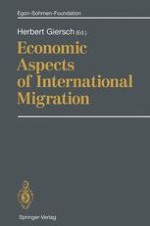1994 | OriginalPaper | Chapter
The National Labor Market Consequences of U.S. Immigration
Authors : Michael J. Greenwood, John M. McDowell
Published in: Economic Aspects of International Migration
Publisher: Springer Berlin Heidelberg
Included in: Professional Book Archive
Activate our intelligent search to find suitable subject content or patents.
Select sections of text to find matching patents with Artificial Intelligence. powered by
Select sections of text to find additional relevant content using AI-assisted search. powered by
Since the imposition of restrictive entry quotas in the early 1920s, U.S. immigration issues have generally been of little concern to economists. First binding quotas, and later the effects of the depression and World War II, resulted in sharply reduced immigration compared with levels of the late nineteenth and early twentieth centuries. When, during the 1950s, immigration again began to rise toward quota ceilings, population was growing rapidly from other sources, and thus immigration continued to contribute relatively little to U.S. population growth. Moreover, during this period mortality among the aging stock of foreign-born more than offset net immigration, with the consequence that the stock declined by 4.6 million between 1930 and 1970. What attention was directed at international migration issues during this half century was mainly on the part of economic historians, who focused on the period of unrestricted flows, and on the part of those interested in the brain drain, who were concerned with the flow of high-level manpower from poor to rich countries.
